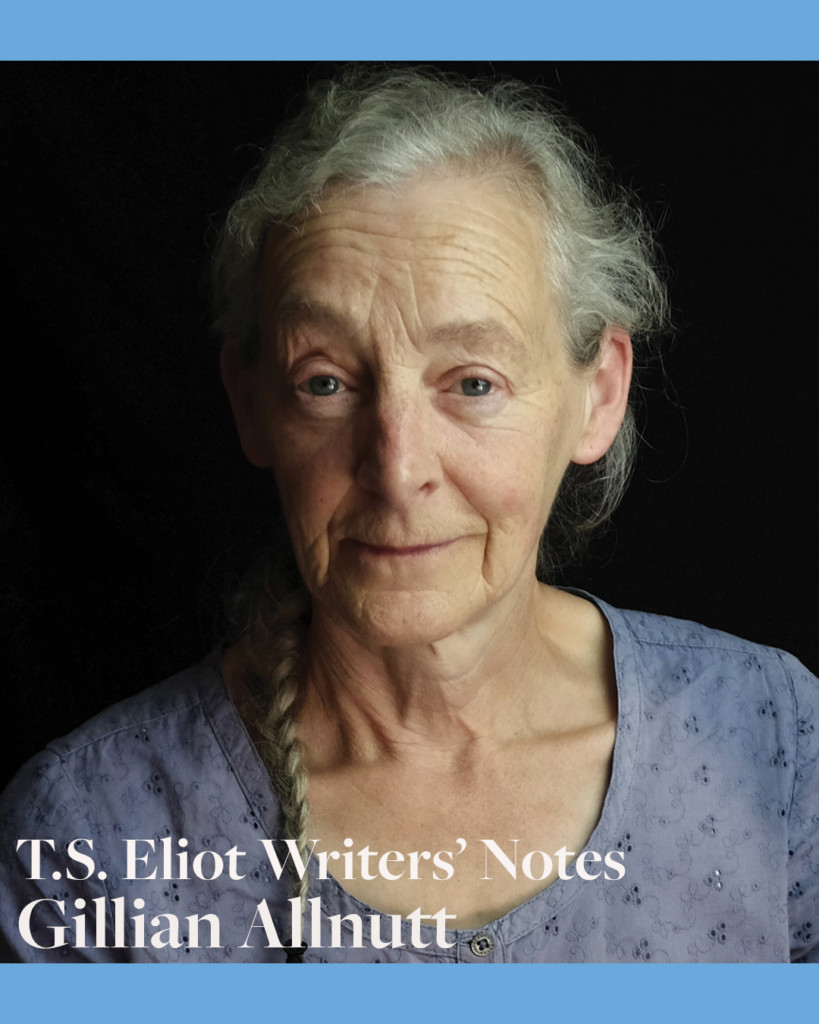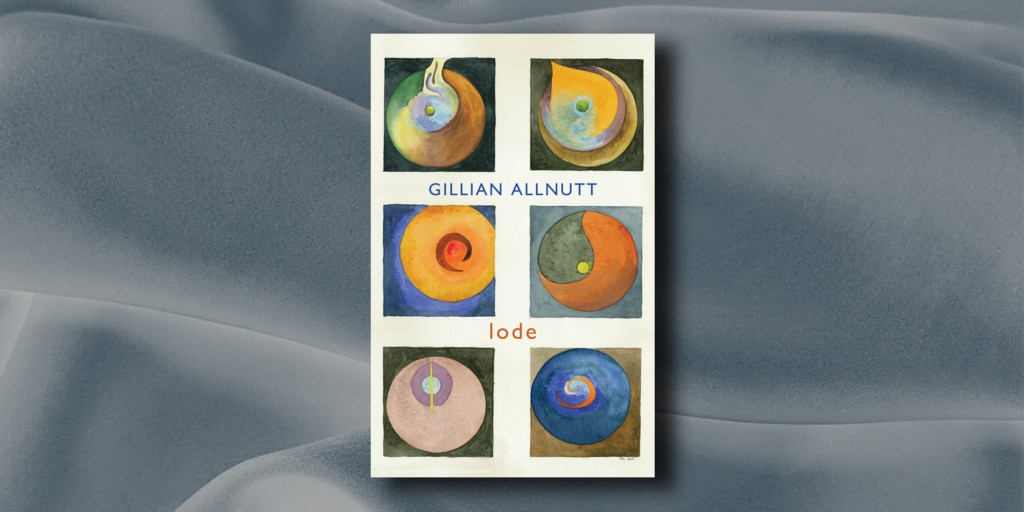Welcome to our Writers’ Notes for the 2025 T.S. Eliot Prize shortlist. These are educational resources for poets looking to develop their practice and learn from some of contemporary poetry’s most exciting and accomplished voices. Here’s Gillian Allnut on her collection Lode.
Finding Forms
‘I love this poor earth for I have known no other’ is, as far as I know, a homeless quote from the Russian poet Osip Mandelstam (1891-1938). I think I remember reading it in one of his letters. I love it enough to have pinched it for the title of a poem. I love it for its honesty, its vulnerability.
In the summer of 1976, before coming to the end of a couple of months in the USA, I attended a writers’ workshop in NYC where we, the would-be poets, were advised to try our hand at different poetic forms. I liked the workshop. So I came back to London, to the garret in the squat off the Caledonian Road where I lived and wrote, and tried a sonnet. I didn’t take to the sonnet but there were other forms and approaches to try out – both on my own and later as a creative writing tutor.
Tip One
Here’s a tip that’s worked for me many a time. When I want to keep my hand in, I make myself write a haiku a day. Since the rules of haiku-making in our own creative writing world can be a bit variable, this is what I impose on myself as disciplined but not discouragingly difficult: a haiku has 17 syllables and three lines which don’t always have to be arranged as 5/7/5 syllables and the title doesn’t have to be included in the 17-syllable count but can increase the overall number. If you get behind with the writing, it’s not impossible to do seven or more haikus in one go. I happened to write 40 on this one-a-day basis in the first two or three months of 2020 and four of them eventually found their way into Lode. Have a look for them!
‘Lost’ began life as a joke but (with permission) found its way into Lode as a frontispiece.
‘Wouldst thou witten thy Lord’s meaning in this thing?’ is there because I have both affection and huge regard for Julian of Norwich. When she says ‘All shall be well’ I’m able to go on walking.
‘Footnote’ is by way of being a small joke in passing when laid next to the river’s reverie.
‘Roughage’ began life as a note to go with a print made by a friend. I was delighted when it occurred to me to tuck it in after the Notes at the very end of the book. It fitted!
Tip Two
Here’s a second tip. This may be the thing that, in all these years of writing, I could least have done without. It is writing in persona – that is, in the guise of someone other than yourself. Of course you can do this on your own, but it’s also good to do in a group.
Imagine you’re a Creative Writing Tutor and this is your Workshop Plan!
You will need shells and pictures for the workshop.
Take in a tinful of shells found on any beach and spread the shells out on a table.
Invite people to choose one they like.
Ask them to look at their shell (size, shape, colour); to listen to it (for the sea, perhaps); to touch it (for hardness/softness, smoothness or ridges); to smell it.
Tell everyone to write seven questions to ask their shell.
Get the pictures out and spread them on another table. (All the pictures should have one or more people in them. Preferably paintings rather than photos.)
Invite people to choose one they like and study it closely. (If there’s more than one person in their picture, they must choose which one they’d most like to be.)
Here’s the tricky bit!
Tell them to answer, as that person, the seven questions they asked their shell.
Ask everyone to read out their answers.
Write for 20/30/40 minutes (whatever time’s available) something of the story of their picture-person’s life. Write it as that person and start with one of their lists of answers.
Ask them to read out these beginnings, if there is time.
Finish at home. Bring the finished work to the next session. It can be a poem or prose.
This is important: do the workshop exercise yourself, along with everyone in the group.
I speak as Mary Magdalene in ‘The way she remembered it’ in Lode. I didn’t have to make up this story: it’s there in John’s Gospel, Chapter 12, Verses 1-8. I’ve had a few goes, over the years, at writing as – or, sometimes, just about – Mary Magdalene. This time, however, I’d been given a framework in the form of a commission from the BBC to write a poem to be read on Radio 2’s Good Friday programme of words and music, ‘At the foot of the Cross’. It was 2021 and the Covid/post-Covid isolation afforded me plenty of time to research and write. It didn’t have to be about Mary Magdalene – that was my own choice.
Three things pulled me into this poem. The first was Jesus’s rebuke of Judas’s criticism of Mary. ‘Let her alone!’, worded thus, happens to be an order so colloquial to our ears and part of our world – though it is to be found in the King James Bible of 1611 – it immediately put me ‘on location’ in First Century Bethany. Secondly, I have always been drawn to the alabaster vase – possibly for the sound of the word, possibly because of the translucent beauty of that particular stone. To me it is like the light of the moon – which arrived by itself but is central to the poem.
A commission always has a mechanical urgency of its own, but these things carried the integral urgency I knew from the story itself. The verse from The Song of Songs framed and prefaced this telling of Mary’s story – and also gave me the three-line verse form that shaped the telling.
Oh and this too! For a good two decades of my life ‘The Song of Songs’ was the only Book of the Bible I read – so when I came to recollect it as Mary, it was already in and part of me.
Tip Three
My third tip recommends the Sestina as a form to work with and within. It looks ferociously complicated and my first attempt drove me literally to the edge of panic – but I finished it. Then there were two books that enabled me to believe in the form and put it to good use: a collection of Elizabeth Bishop’s poems and a creative writing must entitled The Making of a Poem: A Norton Anthology of Poetic Forms, edited by Mark Strand and Eavan Boland. On a practical front I cannot recommend it strongly enough for both personal use and creative writing tutoring. The Bishop poem, called simply ‘Sestina’ and about her being in Nova Scotia as a child with her grandmother and the almanac and the Little Marvel Stove, worked its magic upon me, welcoming me into its spaciousness so precisely rendered, and I remain grateful.
To Forthright Friends
I set the members of the Zoom poetry workshop I ran for just over two years during Covid the onerous task of writing a sestina and found myself embroiled in writing what became the poem ‘Flame-thrower’, here in Lode along with its own kitbag or holdall of necessary notes. The silence that succeeded my reading it aloud in the following workshop was broken by my forthright friend, Di Haigh, asking: ‘Was your father mad?’ That question gave me much food for thought and I’d like to record here my gratitude to Di who subsequently died unexpectedly in July 2022, and is remembered here in Lode in the poem ‘for only then can’.
The Poetry School and T.S. Eliot Foundation have long collaborated on celebrating the T.S. Eliot Prize shortlist, highlighting this major fixture in the poetry calendar as a fantastic way into the art form and an opportunity to learn from poets at the top of their craft. This year we have a series of Writers’ Notes from the shortlisted poets.

Gillian Allnutt was born in London but spent half her childhood in Newcastle upon Tyne. Nantucket and the Angel (1997) and Lintel (2001) were shortlisted for the T. S. Eliot Prize and poems from these collections are included in her Bloodaxe retrospective How the Bicycle Shone: New & Selected Poems (2007), a Poetry Book Society Special Commendation. Lode (Bloodaxe Books) is her tenth collection. Since 1983 she has taught creative writing in a variety of contexts, mainly in adult education and as a writer in schools. In 1988 she returned to live in the North East. In 2009/10 she held a writing residency with The Medical Foundation for the Care of Victims of Torture (now Freedom From Torture), working with asylum seekers in Newcastle and Stockton. She won the Northern Rock Foundation Writer’s Award in 2005 and received a Cholmondeley Award in 2010. In 2025 she was made a Fellow of the Royal Society of Literature. Allnutt received The Queen’s Gold Medal for Poetry 2016.

[…] their practice and learn from the poets shortlisted for the T. S. Eliot Prize. Natalie Shapero, Gillian Allnutt and Vona Groarke have written the first of this year’s articles; look out for more by this […]